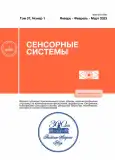Magnetic Navigation of Animals, Contrast Sensitivity of Vision, and the Weber-Fechner Law
- 作者: Binhi V.N.1
-
隶属关系:
- Federal Research Center “Prokhorov Institute of General Physics” of the Russian Academy of Sciences
- 期: 卷 37, 编号 1 (2023)
- 页面: 35-48
- 栏目: ЗРИТЕЛЬНАЯ СИСТЕМА
- URL: https://journals.rcsi.science/0235-0092/article/view/138102
- DOI: https://doi.org/10.31857/S0235009223010031
- EDN: https://elibrary.ru/ATRZSG
- ID: 138102
如何引用文章
全文:
详细
It is known that some animals can react to very small changes in the magnetic field – a thousand times smaller than the geomagnetic field – and use this to navigate the Earth’s magnetic landscape. However, the nature of the molecular magnetic sensor remains unclear, although it has been established that the magnetic sense is associated with vision. It is generally accepted that the operation of a magnetic sensor is based on a magnetochemical reaction. Cryptochromes of photoreceptors lining the retina contain photoinduced spin-correlated pairs of radicals involved in the formation of a nerve impulse and sensitive to a magnetic field. Therefore, the animal could sense the magnetic field as a change in the brightness of large visual fields and orient itself by their contrast. However, the sensitivity of individual sensors – of radical pairs – is known to be very low. Previously, it has been assumed that this difficulty is overcome by a statistical increase in contrast sensitivity due to the parallel processing by the brain of the primary signals of millions of photoreceptors. In the present work, this hypothesis is tested. It has been found that the threshold sensation of brightness contrast almost linearly depends on the logarithm of the angular size of contrasting stimulus, which is typical for the physiology of sensations that obey the Weber-Fechner law. Contrast sensitivity increases with the number of photoreceptors involved in stimulus recognition, however this increase is not quantitatively sufficient to reliably explain the magnetic navigation of animals.
作者简介
V. Binhi
Federal Research Center “Prokhorov Institute of General Physics” of the Russian Academy of Sciences
编辑信件的主要联系方式.
Email: vnbin@mail.ru
Russian Federation,
119991, Moscow, GSP-1, 38 Vavilov St.
参考
- Астахова Л.А., Ротов А.Ю., Кавокин К.В., Чернецов Н.С., Фирсов М.Л. Связь магнитного компаса и фоторецепции у птиц: гипотезы и нерешенные вопросы. Журнал общей биологии. 2019. Т. 80. № 2. С. 83–94. https://doi.org/10.1134/S0044459619020040
- Муравьева С.В., Пронин С.В., Шелепин Ю.Е. Контрастная чувствительность зрительной системы человека. Экспериментальная психология. 2010. Т. 3. № 3. С. 5–20.
- Домбругов Р.М. Телевидение. Киев. Вища Школа. 1979.
- Красильников Н.Н., Шелепин Ю.Е. Функциональная модель зрения. Оптический журнал. 1997. Т. 64. № 2. С. 72–82.
- Кучерявый А.А. Бортовые информационные системы. Ульяновск. УлГТУ. 2004.
- Bertalmio M. Vision мodels for high dynamic range and wide colour gamut imaging. London: Acad. Press, 2020.
- Binhi V.N., Prato F.S. Biological effects of the hypomagnetic field: An analytical review of experiments and theories. PLoS ONE. 2017. V. 12. № 6. P. e0179340. https://doi.org/10.1371/journal.pone.0179340
- Binhi V.N., Prato F.S. Rotations of macromolecules affect nonspecific biological responses to magnetic fields. Scientific Reports. 2018. V. 8. № 1. P. 13495. https://doi.org/10.1038/s41598-018-31847-y
- Blackwell H.R. Contrast thresholds of the human eye. J. Opt. Soc. America. 1946. V. 36. № 11. P. 624–643.
- Buchachenko A. Magneto-biology and medicine. New York. Nova Science. 2014.
- Crumey A. Human contrast threshold and astronomical visibility. Monthly Notices of the Royal Astronomical Society. 2014. V. 442. № 3. P. 2600–2619. https://doi.org/10.1093/mnras/stu992
- Curcio C.A., Sloan K.R., Kalina R.E., Hendrickson A.E. Human photoreceptor topography. The Journal of Comparative Neurology. 1990. V. 292. № 4. P. 497–523.
- Hore P.J., Mouritsen H. The radical-pair mechanism of magnetoreception. Annual Review of Biophysics. 2016. V. 45. № 1. P. 299–344. https://doi.org/10.1146/annurev-biophys-032116-094545
- Lohmann K.J., Lohmann C.M., Ehrhart L.M., Bagley D.A., Swing T. Animal behaviour: geomagnetic map used in sea-turtle navigation. Nature. 2004. V. 428. № 6986. P. 909–910. https://doi.org/10.1038/428909a
- Nadler M.P., Miller D., Nadler D.J. (Eds). Glare and contrast sensitivity for clinicians. New York: Springer-Verlag, 1990.
- Pelli D.G., Bex P. Measuring contrast sensitivity. Vision Research. 2013. V. 90. P. 10–14. https://doi.org/10.1016/j.visres.2013.04.015
- Pishchalnikov R.Y., Gurfinkel Y.I., Sarimov R.M., Vasin A.L., Sasonko M.L., Matveeva T.A., Binhi V.N., Baranov M.V. Cardiovascular response as a marker of environmental stress caused by variations in geomagnetic field and local weather. Biomedical Signal Processing and Control. 2019. V. 51. P. 401–410. https://doi.org/10.1016/j.bspc.2019.03.005
- Riccó, A. Relazione fra il minimo angolo visuale e l’intensitГ luminosa. Memorie della Societa Degli Spettroscopisti Italiani. 1877. V. 6. P. B29–B58.
- Schulten K., Swenberg C., Weller A. A biomagnetic sensory mechanism based on magnetic field modulated coherent electron spin motion. Zeitschrift fur Physikalische Chemie. 1978. V. 111. № 1. P. 1–5.
- Stöckl A.L., O’Carroll D.C., Warrant E.J. Neural summation in the hawkmoth visual system extends the limits of vision in dim light. Current Biology. 2016. V. 26. № 6. P. 821–826. https://doi.org/10.1016/j.cub.2016.01.030
- Wan G., Hayden A.N., Iiams S.E., Merlin C. Cryptochrome 1 mediates light-dependent inclination magnetosensing in monarch butterflies. Nature Communications. 2021. V. 12. № 1. P. 771. https://doi.org/10.1038/s41467-021-21002-z
- Watson A.B., Ahumada A.J. A standard model for foveal detection of spatial contrast. Journal of Vision. 2005. V. 5. № 9. P. 717–740. https://doi.org/10.1167/5.9.6
- Weisstein E.W. Beta Binomial Distribution. From MathWorld – A Wolfram Web Resource. URL: https://mathworld.wolfram.com/BetaBinomialDistribution.html (accessed 2022.07.18).
补充文件















